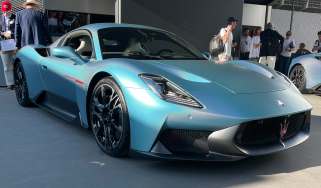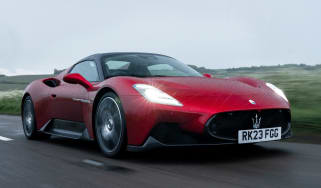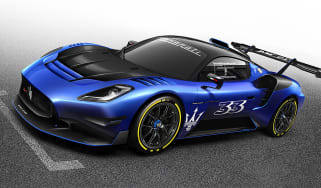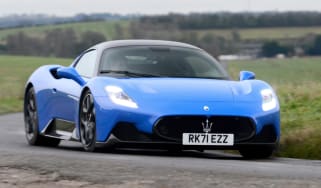Maserati MC20 review
The MC20 is a real return to form for Maserati, and bears comparison with the very best supercars

Maserati hasn’t always hit the target on its first attempt, but with the MC20 it has come almost out of nowhere with one of the best supercars on sale - absolutely matching the best from Ferrari, McLaren and Lamborghini despite an 18-year hiatus in the supercar market.
From the way the MC20 looks to the drama of getting in, thumbing the starter button and pulling away, you’re not left in any doubt as to the car’s purpose. That it can retain this initial drama with savage performance and a pliant but hugely capable chassis is the icing on the cake. Available in both closed coupe and open-topped Cielo form, the MC20 is capable, charming, and very fast indeed.
About the Maserati MC20
Maserati’s last true supercar was the Ferrari Enzo-based MC12, but the Maserati MC20 is a very different prospect - and this time it’s a Maserati from the ground up, with an entirely new platform and a Maserati-designed engine. They’ve given it a character unlike any other supercar on sale.
Maserati worked with motorsport specialists Dallara on the MC20’s carbon fibre structure. As well as featuring double-wishbone suspension at each corner, the chassis is stiff enough that Maserati also offers an open-topped variant called the MC20 Cielo alongside the coupe. This open version does, however, feature changes under the skin, such as different carbon fibre weaves and thicknesses to ensure it drives no differently from the coupe. Maserati claims the monocoque chassis weighs only around 100kg.
Used - available now

2024 MG
MG4 EV
12,680 milesAutomaticElectric
Cash £16,900
2022 Renault
Captur
53,877 milesManualPetrol1.3L
Cash £13,100
2026 Volkswagen
Taigo
22,175 milesManualPetrol1.0L
Cash £15,000
2024 Volkswagen
Taigo
29,350 milesManualPetrol1.0L
Cash £14,500Entry to either MC20 model is via impressive ‘butterfly’ doors, while the Cielo’s roof is a rigid folding unit rather than a soft top. It’s fully electric and does its stuff in around 12 seconds, at speeds of up to 31mph. The panel is clever too, changing between opaque or clear at the press of a button. The Cielo also features different suspension settings to the coupe, again to preserve the way it drives despite a little extra weight.
The engine meanwhile is a 3.0-litre, twin-turbo V6 that Maserati calls the ‘Nettuno’. It features both direct and indirect fuel injection, twin spark plugs per cylinder - something Maserati says is derived from F1 technology - and is attached to a standard dual-clutch transmission. The Nettuno is good for 621bhp and a brawny 730Nm of torque - and that’s enough to make this a true 200mph supercar. Optional carbon-ceramic brakes ensure it’ll repeatedly stop like one too.
Supercar buyers are spoiled for choice and there are plenty of other options that might tempt you away from an MC20. The most obvious is probably the latest supercar from Maserati’s long-time rival and sometime partner Ferrari, the 296 GTB. It too is available in both coupe and Spider forms and while it’s priced a shade higher, if you’re considering one you’ll most likely be considering the other. The same applies to the McLaren Artura, and if you appreciate the Maserati’s drama then a Lamborghini Huracan will probably appeal too.
Engines, performance and drive
A mid-engined layout might be de rigueur in the supercar class, but Maserati has managed to deliver a unique driving experience from such a familiar layout, one that can stand on its own among some very talented competition.
It sounds strange, but you can almost describe it as being like a scaled-up Alpine A110. In GT mode especially it really flows with the road, yet remains precise, delicate and agile. The MC20 has lovely steering, too, with ideal weighting and a fast but not hyperactive response. If you’re particularly in tune with a car’s behaviour you might notice a slight difference in the way the open-topped Cielo steers, but the difference really is minimal, and the car’s composure isn’t affected by that hole in the roof.
But it can also do aggression, and with Sport and Corsa driving modes (as well as a milder Wet mode), you can ramp up that aggression as desired. In Sport, the car feels sharper and the engine becomes more responsive and more vocal. Switch to Corsa and the car grows horns, with a real savagery to its performance and agility.
In the cars we’ve tested with the optional carbon-ceramic brakes there’s a little more pedal travel than we’d like, but they don’t have any problem shedding speed, and if you tune everything back to GT mode then the driving experience becomes almost serene. It’s certainly long-legged enough for touring, even if the 60-litre fuel tank might mean frequent stops and the rearward visibility, rear-view camera or not, can make manoeuvring tricky.
Engines, 0-60 acceleration and top speed
As with most supercars, there is just one engine available in the Maserati MC20. Luckily, it’s a good one - a Maserati-developed 90-degree twin-turbocharged V6 it calls the ‘Nettuno’. With technology Maserati says is derived from Formula One, such as a combination of direct and indirect injection, and twin spark plugs for each cylinder, it develops 621bhp at 7,500rpm, and can rev to 8,000rpm, while Maserati quotes a hefty 730Nm of torque.
Nettuno might be a reference to the Roman god Neptune - the water god known for wielding a trident, like you’ll find in Maserati’s badge - but it might as well be a future destination, given the MC20’s rocket-like performance. Whether coupe or open-topped Cielo, the MC20 can sprint from 0-62mph in 2.9 seconds, and top speed is quoted at more than 200mph for both - the hard-top as “more than 202mph”, and 201mph on the dot for the Cielo.
But it’s the character and violence of the MC20’s engine that will really grab you, providing savage acceleration from almost any revs and in any of the dual-clutch transmission’s eight ratios. Response increases as you switch from the car’s standard GT mode first to Sport, and then to Corsa, but whatever mode you’re in, the engine delivers whooshes and chirrups while the gearbox has a surprisingly connected, mechanical feel. It’s not the most musical engine, but it certainly has a unique voice.
MPG, CO2 and running costs
Fuel economy is unlikely to be of primary concern to the average Maserati MC20 buyer, but at the same time these kind of cars are designed to be usable, and may be asked to cover large distances in a touring role, so usability is still a factor.
And in context of the car’s performance, a combined figure of 24.4mpg for the coupe, and 24.1mpg for the Cielo, really isn’t all that bad - you’d have been lucky to get low double-figure MPG for some of the earliest 200mph cars. On the MC20’s 60-litre fuel tank, you should be able to stretch to about 300 miles between fill-ups, though if you have any alpine adventures planned, bear in mind this range will drop when using more of the car’s performance.
The economy figures equate to CO2 emissions of 262g/km for the coupe and 265g/km for the Cielo, putting both cars comfortably in the top VED band, with a first-year bill of £2,605 - though on a list price of more than £190,000, you probably won’t notice.
Insurance groups
Maserati doesn’t list insurance groups for the MC20 in its literature but you can expect it to sit in the upper reaches of the 1-50 grouping system - and clients at this level are more likely to find specialist insurance than trawling through an online comparison website.
Depreciation
More conventional Maseratis have often lost value like milk left in the sun, but while you’d be lucky to get a third of what you pay for some variants of the Ghibli or Levante after three years and 36,000 miles, our data shows that MC20 owners will fare much better - the supercar is expected to retain more than 56 per cent of its asking price over the same period.
To get an accurate valuation on a specific model check out our free car valuation tool...
Interior, design and technology
You’d hope a new Maserati supercar would be beautiful, and we reckon the MC20 delivers. Flowing curves meet with sharp edges and design details to form one squat, purposeful and wonderfully proportioned whole, while certain details have hints of the old Enzo-based MC12. And don’t just take our word for it - each time we’ve driven the Maserati MC20, it’s been accompanied by swivelling heads everywhere we’ve gone. This is clearly a car that attracts attention, which potential owners are sure to love.
The best supercars can also bring drama to the process of simply getting in, and as the MC20’s butterfly doors open skywards, it ticks that box too. You then slide in through those amazing doors and are met by a cabin that strikes a wonderful balance between comfort and road-going racer.
The layout is simple but purposeful, with a three-spoke steering wheel that incorporates the starter button, a digital display behind that (flanked by a pair of air vents), and a simple dashboard and centre console, with a wide touchscreen display incorporating the car’s infotainment system. As you’d expect, Maserati offers a number of options to let you personalise the car both inside and out, from a choice of six exterior colours, to carbon fibre packs and unique stitching.
In the Cielo, extra surprise and delight comes from the roof - even when it’s up (and it’s a 12-second process to electrically raise or lower), you can switch between opaque or clear, thanks to polymer-dispersed liquid crystals activated by an electric current.
Sat-nav, stereo and infotainment
In addition to a 10.2-inch information display ahead of the driver, the MC20 gets a wide and narrow 10.25-inch infotainment screen in the centre of the dashboard. This screen is also used to control the car’s climate control - there are no physical buttons - but thankfully it works well enough, while the ability to pair up a smartphone means basic functions such as navigation and audio are straightforward. There’s also Alexa and Google Assistant integration, and the option of a powerful Sonus Faber audio system.
Practicality, comfort and boot space
The Maserati MC20 successfully blends the twin requirements of a sports car and a grand tourer as far as interior space, atmosphere and comfort are concerned. The cabins of both the coupe and the Cielo are effectively the same, the only notable difference being that optional gap in the roof, so there’s no real compromise for choosing the open-topped car, and luggage space is the same in both.
That also applies to the well thought-out driving position, and if you do go for the Cielo, and put the roof down, then at most speeds wind noise and cabin bluster is kept to a minimum. The only real downside in both is rearward visibility - it basically doesn’t exist. A digital rear-view mirror mitigates this. One box we’d recommend ticking when you order is the optional nose lift, giving you some extra breathing room over speed bumps.
Dimensions and size
At 4,669mm long, 1,965mm wide (not including mirrors), and only 1,224mm tall, the MC20 certainly has traditional supercar proportions, and they make it just a touch longer and wider than a Ferrari 296, and slightly taller. At 2,178mm wide from the tips of its mirrors you might need to breathe in (or fold them in!) between width restrictors, but the MC20 doesn’t actually feel that big from behind the wheel.
Leg room, head room and passenger space
With only two seats to consider and a clean sheet to start with for the carbon tub, Maserati has been able to provide plenty of room for driver and passenger in the MC20, and the butterfly doors mean getting in isn’t too much of a challenge either.
Boot space
The MC20 offers two luggage areas, with a front compartment of 50 litres and 100 litres in the rear. Naturally, Maserati will help you fill these with its own branded luggage, but if this sounds a bit cynical then it may not be such a bad idea to make full use of the limited space.
Reliability and safety
Not quite enough of you drive Maseratis for the brand or any of its models to have appeared in the 2022 Driver Power customer satisfaction survey, and the same applies to any of the MC20’s rivals, so it’s difficult to say how they compare as an ownership proposition.
Historically some of the brand’s models have had a reputation for fragility and expensive repair bills, but Maserati has worked hard to improve quality in recent years, and like its premium rivals, Maserati now offers comprehensive servicing packages, extended warranties, and roadside assistance. And in our experience of the car so far, it has appeared both well-built and fault-free.
You may be unsurprised to learn that Euro NCAP hasn’t crashed any MC20s in the pursuit of safety testing, but a motorsport-style carbon tub, airbags, and electronic safety nets, plus the active safety benefits of high levels of grip and braking ability, provide reassurance.
Warranty
All Maseratis come with a three-year warranty as standard. The mainstream range then offers an optional five-year extension with unlimited mileage, and up to seven years covering the car’s mechanical components, but Maserati hasn’t yet revealed whether this will also apply to the MC20. Maserati does offer what it calls an Extra10 warranty for driveline cover up to the car’s tenth year, covering all models except the brand’s electric vehicles.
Servicing
Pre-paid maintenance programmes are available on the MC20, just as they are on other Maserati models. In the MC20’s case, they’re offered under an MC20 Premium Service package, covering the first three to seven visits, and include a complimentary pick up and delivery service where available.










